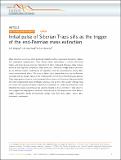Initial pulse of Siberian Traps sills as the trigger of the end-Permian mass extinction
Author(s)
Burgess, S. D.; Muirhead, J. D.; Bowring, Samuel A.
Downloads41467-017-00083-9.pdf (712.8Kb)
Terms of use
Metadata
Show full item recordAbstract
Mass extinction events are short-lived and characterized by catastrophic biosphere collapse and subsequent reorganization. Their abrupt nature necessitates a similarly short-lived trigger, and large igneous province magmatism is often implicated. However, large igneous provinces are long-lived compared to mass extinctions. Therefore, if large igneous provinces are an effective trigger, a subinterval of magmatism must be responsible for driving deleterious environmental effects. The onset of Earth's most severe extinction, the end-Permian, coincided with an abrupt change in the emplacement style of the contemporaneous Siberian Traps large igneous province, from dominantly flood lavas to sill intrusions. Here we identify the initial emplacement pulse of laterally extensive sills as the critical deadly interval. Heat from these sills exposed untapped volatile-fertile sediments to contact metamorphism, likely liberating the massive greenhouse gas volumes needed to drive extinction. These observations suggest that large igneous provinces characterized by sill complexes are more likely to trigger catastrophic global environmental change than their flood basalt-and/or dike-dominated counterparts.
Date issued
2017-07Department
Massachusetts Institute of Technology. Department of Earth, Atmospheric, and Planetary SciencesJournal
Nature Communications
Publisher
Nature Publishing Group
Citation
Burgess, S. D. et al. “Initial Pulse of Siberian Traps Sills as the Trigger of the End-Permian Mass Extinction.” Nature Communications 8, 1 (July 2017) © 2017 The Author(s)
ISSN
2041-1723